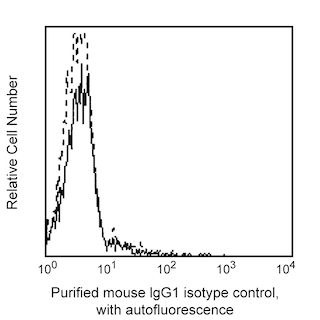-
Your selected country is
Middle East / Africa
- Change country/language
Old Browser
This page has been recently translated and is available in French now.
Looks like you're visiting us from {countryName}.
Would you like to stay on the current country site or be switched to your country?




Flow cytometric analysis of CD151 expression on human peripheral blood platelets. Platelets were stained with either Purified Mouse Anti-Human CD151 (Cat. No. 556056; solid line histogram) or Purified Mouse IgG1, κ Isotype Control (Cat. No. 555746; dashed line histogram), followed by FITC Goat Anti-Mouse IgG/IgM (Cat. No. 556056). Fluorescent histograms were derived from gated events with the side and forward light-scattering characteristics of viable platelets.


BD Pharmingen™ Purified Mouse Anti-Human CD151

Regulatory Status Legend
Any use of products other than the permitted use without the express written authorization of Becton, Dickinson and Company is strictly prohibited.
Preparation And Storage
Product Notices
- Since applications vary, each investigator should titrate the reagent to obtain optimal results.
- An isotype control should be used at the same concentration as the antibody of interest.
- Caution: Sodium azide yields highly toxic hydrazoic acid under acidic conditions. Dilute azide compounds in running water before discarding to avoid accumulation of potentially explosive deposits in plumbing.
- Sodium azide is a reversible inhibitor of oxidative metabolism; therefore, antibody preparations containing this preservative agent must not be used in cell cultures nor injected into animals. Sodium azide may be removed by washing stained cells or plate-bound antibody or dialyzing soluble antibody in sodium azide-free buffer. Since endotoxin may also affect the results of functional studies, we recommend the NA/LE (No Azide/Low Endotoxin) antibody format, if available, for in vitro and in vivo use.
- Please refer to www.bdbiosciences.com/us/s/resources for technical protocols.
Companion Products

.png?imwidth=320)
Reacts with platelet-endothelial cell tetraspan antigen-3 (PETA-3), a 27 kD membrane glycoprotein, expressed on platelets, megakaryocytes, lymphocytes (weak), monocytes, endothelial cells and epithelial cells. PETA-3 (CD151) associates with β1 integrin in certain tissues. This has also been shown with other tetraspan superfamily members, like CD9, CD63 and α5β1. Reports indicate that this association or colocalization of CD151 with β1 integrin in tissues suggests a functional role of this molecule, however, this role has not been elucidated yet. It has also been reported that antibody 14A2.H1 is capable of platelet activation in vitro. Studies showed that different clones of CD151 monoclonal antibodies display strikingly different patterns of binding to human haemopoietic cells and tissue sections, and that this is due at least in part to the presence of the protein in complexes with different integrins.
Development References (5)
-
Fitter S, Tetaz TJ, Berndt MC, Ashman LK. Molecular cloning of cDNA encoding a novel platelet-endothelial cell tetra-span antigen, PETA-3. Blood. 1995; 86(4):1348-1355. (Biology). View Reference
-
Geary SM, Cambareri AC, Sincock PM, Fitter S, Ashman LK. Differential tissue expression of epitopes of the tetraspanin CD151 recognised by monoclonal antibodies.. Tissue Antigens. 2001; 58(3):141-53. (Clone-specific: Flow cytometry, Immunohistochemistry, Immunoprecipitation). View Reference
-
Kishimoto T. Tadamitsu Kishimoto .. et al., ed. Leucocyte typing VI : white cell differentiation antigens : proceedings of the sixth international workshop and conference held in Kobe, Japan, 10-14 November 1996. New York: Garland Pub.; 1997.
-
Roberts JJ, Rodgers SE, Drury J, Ashman LK, Lloyd JV. Platelet activation induced by a murine monoclonal antibody directed against a novel tetra-span antigen. Br J Haematol. 1995; 89(4):853-860. (Biology). View Reference
-
Sincock PM, Mayrhofer G, Ashman LK. Localization of the transmembrane 4 superfamily (TM4SF) member PETA-3 (CD151) in normal human tissues: comparison with CD9, CD63, and alpha5beta1 integrin. J Histochem Cytochem. 1997; 45(4):515-525. (Biology). View Reference
Please refer to Support Documents for Quality Certificates
Global - Refer to manufacturer's instructions for use and related User Manuals and Technical data sheets before using this products as described
Comparisons, where applicable, are made against older BD Technology, manual methods or are general performance claims. Comparisons are not made against non-BD technologies, unless otherwise noted.
For Research Use Only. Not for use in diagnostic or therapeutic procedures.
Report a Site Issue
This form is intended to help us improve our website experience. For other support, please visit our Contact Us page.